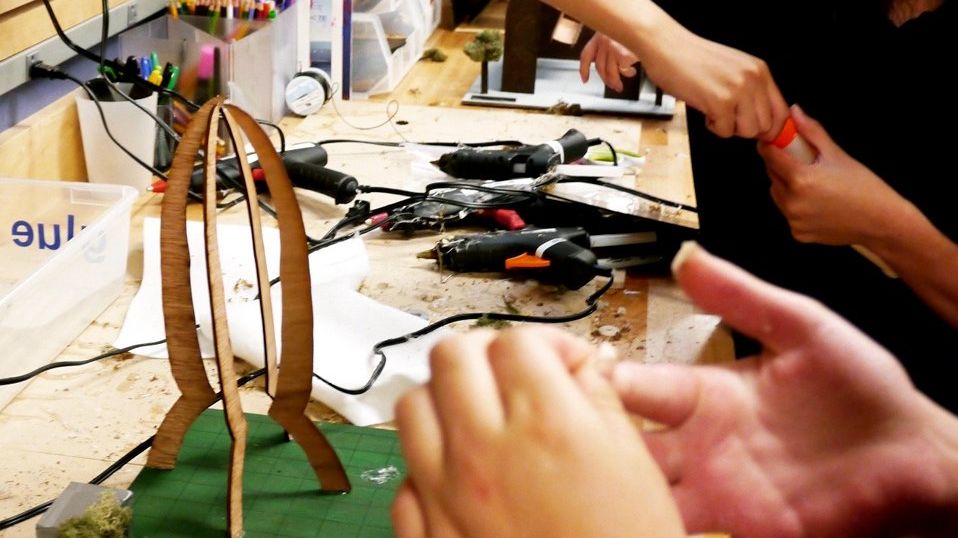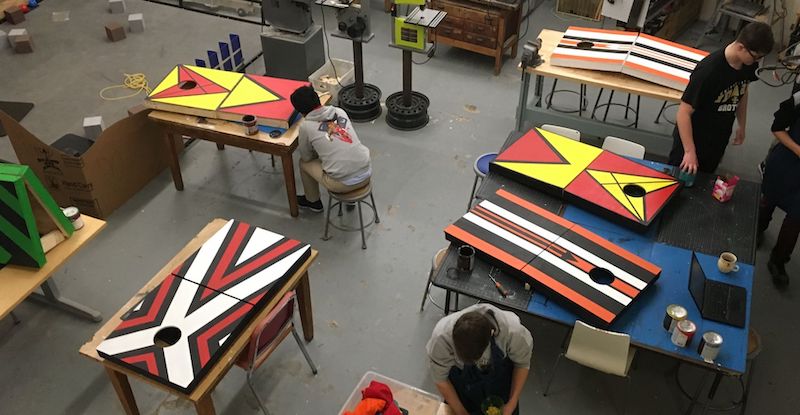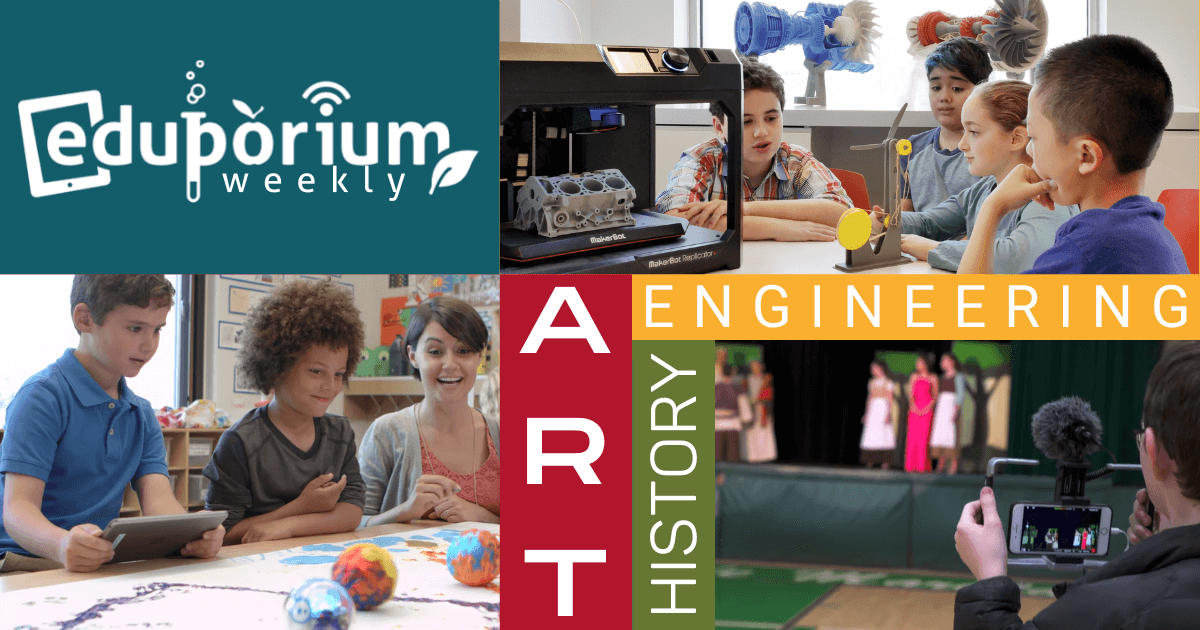You probably know by now that we are huge advocates of makerspaces in education. The freedom for creativity, hands-on learning, exploration, and experimentation that they provide for students helps them learn in so many unique ways. Some school leaders have even gone as far as to create a full makerspace curriculum or afterschool initiatives upon seeing all of the ways that students could benefit. But, one of the great things about makerspace learning is that teachers can adopt it at just about any time and as part of just about any academic subject. So, if you’re an English teacher, a history teacher, or a math teacher and don’t think makerspaces are for you, we’re here to tell you that they could be.
Makerspaces and ELA
Makerspaces open up various creative avenues for students to explore new ways of thinking while solving challenges. Of course, in an ELA classroom, there is a lot of reading and writing that takes place. Children don’t always have the creative juices flowing, though, and might tend to become frustrated when they find themselves struggling for ideas to write about. This is where makerspace experiences and ELA can merge. If students have access to different tools in their makerspaces, they could use them to design characters, create plot line projects, and even their own stories. It seems simple but it could absolutely help students start to think more creatively in their English classes.
Using a makerspace for ELA instruction.
Also, since students read various novels and short stories, educators can weave those into makerspaces, too. Using maker materials, children could work together in groups to construct props, settings, and even characters. Then, they can use them to correlate with how they’re picturing what’s happening in the books they’re reading. Typically, students act pretty compulsively in all different types of makerspaces and start building whatever pops into their heads, which is awesome. Teachers can also potentially apply that same kind of stream of consciousness to makerspace learning in ELA classes. It's a fantastic way for them to highlight storytelling in education and, of course, allow students to convey their messages creatively.
Strengthening writing and storytelling.
In terms of writing, students can also benefit from their makerspace experiences when generating creative content. Even something as simple as getting up from their seats could help get the creative juices flowing. Kids can also share their projects and create descriptions about what they’ve made or why it’s relevant to a story. In fact, one of the best ways to leverage a makerspace in ELA is to leave sticky notes everywhere. As students work with their hands and build tangible objects, they can jot down the inspiration that strikes on the note cards. Then, they can come back to their creative thoughts later when they sit down to write. Of course, this is just one example and teachers could find tons of other ways to combine these areas!
Makerspaces in History
History class isn’t something we would typically associate with STEAM education but the point of this post is to show how makerspaces can help in unique ways. Traditionally, we associate most history classes with memorizing dates and events. Even though we've definitely steered away from that in recent years, history isn’t really something that’s super interactive. Also, the fact that school makerspaces are typically filled with technology and a focus on STEM learning naturally makes us think more about the future. For example, 3D printers are popular materials in makerspaces. So, you might be wondering how those can fit into a history class. And, of course, there are some answers to that very question.
Bringing history lessons to a makerspace.
If you’re willing to try, it’s possible to incorporate STEM elements like electronics, 3D printing, and coding into history lessons. First off, there is so much history that has happened over the course of time. If you're able to bring some 3D printers into your classroom, library, or makerspace, there are so many designs that your students could 3D print. Side note—if you don’t have 3D printers, check out our store or apply for our monthly EdTech grant. Anyway, whatever period of time or historic event you are studying in history class, chances are there’s an artifact, figure, or landscape that students could create a design for and 3D print.
The potential of these projects.
A popular approach in makerspaces is for students to create something that demonstrates that they have understood a particular concept. This can work as part of history classes so that children could show that they understand how historical events tie together. They could even keep it simple and use MakerEd skills to create a 3D timeline of a historical period. Or, they could 3D print models of anything from the ancient pyramids to Mount Rushmore—depending on their skill sets. As they do this, educators should reinforce design thinking principles. This can get students thinking about how technology can help them create all sorts of things. It's also equally relevant when they’re in the makerspace and when they’re outside of it.

Makerspaces and Engineering
It might not be a surprise but makerspace learning creates a fine opportunity to integrate engineering into this experience. Some common materials that teachers typically add to makerspaces are used cardboard, glue, scraps of various types of metal, and others—all of which students could use for building. And, when students build in their makerspace, their hands and brains work together as they explore creative solutions and take part in the engineering process. Throughout this process, they need to think like they're engineers despite using some basic building materials. They also must consider things like the longevity of what they are building, how to make it support its own weight, or how it could support the weight of something else.
Engineering projects in the makerspace.
When teaching engineering values and approaches in their makerspace, teachers have the opportunity to incorporate other key concepts, too. One of those is upcycling. This involves children turning old materials into something useful by simply restoring them or connecting them to other pieces. This helps all students see that they can make something better than the original by using their imaginations. Other construction-related activities in the makerspace can fall anywhere from very basic to something more on the advanced side. With just basic materials, like paper and tape, students can engineer all kinds of meaningful projects. These include classics like bridges and towers or some that are more complex, like dams or catapults.
Benefits of engineering education.
Practice at basic engineering can allow for a lot of different projects, which is good for both teachers and students. Aside from building devices and testing whether or not they can support other objects, students could also work together to engineer things that can float, for example. This is perfect if you have a bunch of cardboard lying around. Students could team up or work on their own to see who can build a cardboard boat that can withstand the force of the rough waters (of course, you would need to make sure you have a pool or a nearby body of water to test them in). Honestly, a lot of the activities done in a makerspace could involve engineering. This is true, especially, since two of the most common makerspace materials are still cardboard and duct tape. Plus, it's great because engineering skills are certainly good to have!
Social Studies and Makerspaces
There are a handful of characteristics that contribute to making makerspace learning and projects grand educational experiences for students. The characteristics of the projects aren’t dependent on the subject area either. Teachers could adapt their instruction and hands-on projects to almost any K-12 subject area, including social studies. For example, great makerspace projects often allow students to incorporate their design thinking skills when problem solving, building, and tinkering. They'll also tend to be either short- or long-term in nature. They could also be tightly structured with certain guidelines or loose to allow students the maximum freedom to create.
Recreating common social studies lessons.
These characteristics apply to bringing social studies education into the makerspace as well as any other academic subject. Typically, a lot of social studies education involves reading from the textbook or viewing documentaries. This is often how students learn about past events or how modern societies are set up and function. What if they embraced the hands-on element of makerspaces, however? They could act some of these things out with their classmates to truly show that they've understood every important concept. They wouldn’t even necessarily need to ‘make’ anything but could certainly work that in if possible. Then, there’s also the route of creating 3D projects, like dioramas. This allows students to illustrate their understanding of key social studies concepts in that way.
Tech, social studies, and makerspace projects.
Another option that’s popular among teachers and children is podcasting. There are tools, like the line of Padcaster multimedia devices, available to help you create podcasts with students but, if you’d also like to try something more traditional, helping students create a play to illustrate what they’re learning in social studies is certainly feasible, too. If your first thought is wondering how writing and performing a play ties in with the maker learning, here’s your answer. Students could work together to brainstorm and create every physical object used in each play in their makerspace. They could create and customize costumes, design sets and scenes, or 3D print props or other tangible objects for characters. It's really a great way for them to combine hands-on makerspace learning with the classic themes of social studies.

Makerspaces Throughout the Curriculum
When they first became popular in education, makerspaces were essentially seen as a way for teachers to enhance learning by giving kids the freedom to work with their hands, collaborate often, try new things, fail, invent, and more. After realizing how much these experiences could contribute to actual learning, however, many school leaders decided to allow makerspace time to count towards academic achievements. Or, like in some cases, they even require it for certain classes. As we’ve discussed, makerspace learning can take place throughout the entire curriculum in subjects like history and English rather than just STEAM subjects as some people might assume. And, school makerspaces have evolved to include more than just the busy work—they’re somewhere students truly want to be.
Shifting to a makerspace classroom.
For a while, STEAM educators and their students reaped the benefits of makerspaces while non-STEAM teachers were looking on and wondering how they could capitalize. After trying out different approaches, educators in different subject areas have found effective ways to bring makerspace opportunities to their students. And, many have done so simply by adopting the right frame of mind for success. One common suggestion is returning to the roots of education and remembering one of its foundational theories known as constructivism. Constructivism can apply to pretty much any school subject area since it embodies the entire idea of learning by doing. This idea is bigger than any subject and, when it first emerged, it was to revolutionize learning in all areas. And, that's really similar to what teachers today do in makerspaces.
The value of makerspace time.
One reason that makerspace learning has grown is that making isn’t exclusively about producing tangible projects. It’s simply about just producing something. That something may be a physical object, a story, or even an idea—brought to life by giving students the chance to collaborate and activate their imaginations. Of course, adding a physical making experience can help them use first-hand experience to bolster hard and soft skills for succeeding in the future. We shouldn’t underestimate the value of helping students to develop skills like creativity, collaboration, and problem solving. Students can sharpen each of these in a makerspace and teachers can help when teaching any subject in the curriculum. So, all in all, maker and STEAM education have helped educators accomplish a lot—are you ready to try?
For the latest EdTech, STEM, and 21st century education news, follow us on Twitter and Instagram. Like us on Facebook, too, or sign up for our newsletter for announcements on new product offerings! If you have an idea for an Eduporium Weekly theme, send us a message on social media or comment below.



